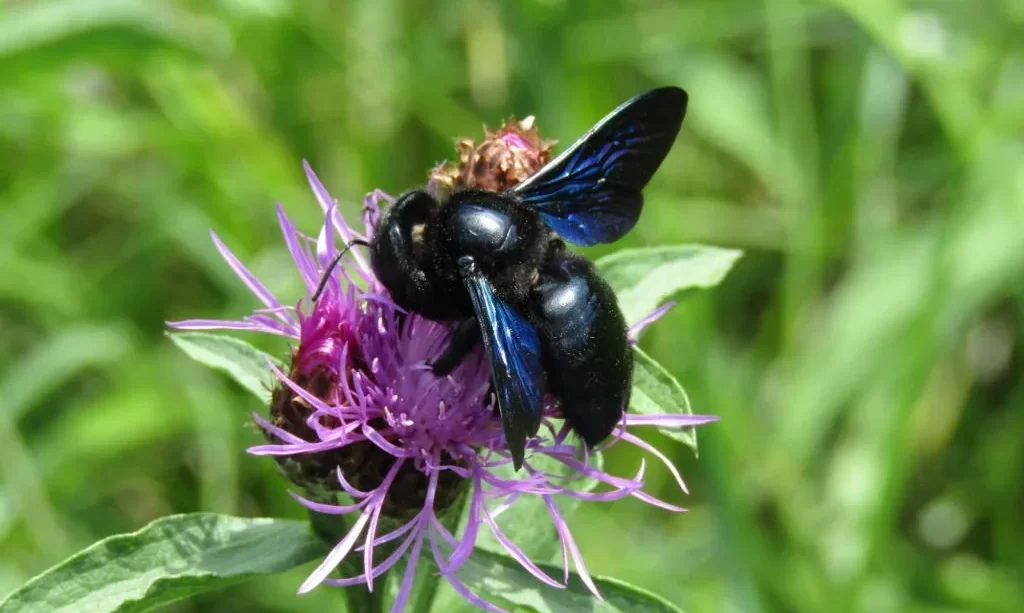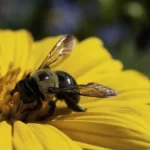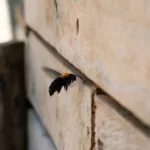Carpenter bees, with their distinctive buzzing presence, are not only remarkable for their wood-boring habits but also for their essential role as pollinators. Understanding what carpenter bees eat is a crucial aspect of appreciating their contribution to our ecosystems. While these solitary bees are often associated with wooden structures, it’s their foraging behavior and dietary preferences that we’ll explore in this guide. By delving into what sustains carpenter bees, we can gain insights into their vital role in the natural world and our gardens.
- Foaming Solution: Our Carpenter Bee Killer Spray employs a distinctive foaming formula designed to efficiently target and eradicate undesired insects. Utilizing its specialized foaming technology, it penetrates deeply into nests and crevices.
- Household Safety: Our formula, devoid of harsh chemicals, ensures suitability for use around your loved ones, including children and pets, prioritizing their well-being while effectively combating carpenter bees and other insects.
- Enhance Defense: Bid farewell to temporary fixes! Our spray swiftly eliminates carpenter bees within minutes and offers prolonged defense against future insect invasions. Keep your home guarded from unwanted bugs intruder.
- Adaptable Application: From backyard to shed, porch to patio, our spray is versatile enough to handle carpenter bee troubles on various surfaces like wood, metal, and plastic. Enjoy comprehensive coverage wherever you need it.
- Simple Usage: No complex procedures Just shake, aim, and spray. Our foaming formula clings to surfaces for thorough reach and distribution coverage, sparing you from frequent reapplications
Carpenter Bee Foraging Behavior
Carpenter bees are diligent foragers, and their dietary choices play a pivotal role in their life cycle. Here are key aspects of carpenter bee foraging behavior:
- Nectar Collection: Carpenter bees are nectar seekers. Nectar serves as their primary energy source, providing carbohydrates that fuel their buzzing flights and daily activities. Their unique adaptations, such as elongated mouthparts, allow them to access nectar from a wide variety of flowers.
- Pollen Gathering: In addition to nectar, carpenter bees collect pollen. Unlike nectar, which provides energy, pollen serves as their source of protein and essential nutrients. Pollen collection is particularly critical for the development of carpenter bee larvae, as it provides the necessary sustenance for their growth.
- Role in Pollination: As carpenter bees visit flowers to gather nectar and pollen, they inadvertently contribute to the pollination of these plants. Pollen from one bloom sticks to their bodies and is transferred to other flowers they visit, facilitating the reproduction of a diverse array of plant species. This role in pollination makes carpenter bees valuable contributors to ecosystems and agriculture.
Understanding carpenter bee foraging behavior illuminates the intricacies of their dietary preferences and the critical role they play in maintaining the health and diversity of plant life.
Nectar as a Primary Energy Source
Nectar takes center stage in the carpenter bee diet, serving as their primary source of energy. Here’s a closer look at this vital component of their sustenance:
- Carbohydrate Rich: Nectar is a carbohydrate-rich fluid produced by flowers as a lure for pollinators like carpenter bees. Its high sugar content provides quick and efficient energy, essential for the bees’ buzzing flights and daily activities.
- Adaptations for Nectar Collection: Carpenter bees have specialized adaptations that enable them to efficiently collect nectar. Their mouthparts are elongated, allowing them to reach deep into flowers to access nectar reserves. This adaptation makes them effective pollinators as they transfer pollen between flowers while foraging for nectar.
- Energy for Flight: Nectar’s role as an energy source is particularly crucial for the flight capabilities of carpenter bees. These bees exhibit remarkable agility and maneuverability in the air, which is sustained by the energy obtained from nectar.
Pollen Collection for Protein
While nectar provides the energy carpenter bees need for their buzzing activities, pollen plays a different yet equally crucial role in their diet:
- Protein and Nutrient Source: Pollen is rich in proteins and essential nutrients, making it a vital component of the carpenter bee diet. It provides the necessary building blocks for the development and growth of bee larvae.
- Pollen-Gathering Mechanism: Carpenter bees employ a distinct method to collect pollen. As they visit flowers for nectar, their bodies inadvertently come into contact with pollen. The hairs on their bodies, especially on the hind legs, capture pollen grains. When they return to their nests, they carry these grains back to provide sustenance for their developing offspring.
Specific Plants and Flowers
Carpenter bees display preferences for certain plants and flowers, which vary depending on the availability of nectar and pollen. Here are key points related to the specific flora that attract carpenter bees:
- Nectar-Rich Selection: Carpenter bees are particularly drawn to nectar-rich flowers. Species like salvia, lavender, and sunflowers are among their favorites. These flowers provide ample nectar reserves, making them attractive for foraging.
- Diverse Foraging Sources: Carpenter bees benefit from a diverse range of forage sources. They visit various plants and flowers, ensuring a balanced diet and supporting the pollination of a wide array of plant species. This diversity contributes to the health and resilience of ecosystems.
By focusing on nectar for energy and pollen for protein, carpenter bees exemplify their adaptability as both skilled pollinators and diligent foragers.
Role in Pollination
Carpenter bees, in their quest for nectar and pollen, play a pivotal role in the process of pollination. This section explores the significant contribution of carpenter bees to pollination:
- Efficient Pollinators: Carpenter bees are unintentional yet highly effective pollinators. As they forage for nectar and pollen, they brush against the reproductive parts of flowers, transferring pollen from one bloom to another. This pollen transfer is a fundamental step in the fertilization of many plant species.
- Diverse Plant Partnerships: Carpenter bees visit a wide variety of flowers, from garden favorites to wildflowers. In doing so, they facilitate the reproduction of both cultivated and native plant species. This diverse foraging behavior promotes biodiversity and supports the health of ecosystems.
- Agricultural Impact: The pollination services provided by carpenter bees are not limited to wild plants. They also contribute to the pollination of numerous crops, including fruits, vegetables, and nuts. Their role in agriculture underscores their importance in food production and the maintenance of global food security.
- Eliminate Wasps – VisiLure Traps lure wasps, red wasps, mud daubers, and carpenter bees with appealing colors and a multi-dimensional pattern. Once attracted, they become stuck to the sticky surface and expire.
- Choose VisiLure – The VisiLure TrapStik for Wasps lures insects without odors, chemicals, or wasp sprays. It catches queens and workers, from spring through fall.
- Thoughtful Design – Unique Glue Guards create a barrier around the sticky trap surface to reduce the chances of non-insect catches.
- Prevent Damage – Mud daubers (mud wasps, dirt daubers) and carpenter bees can cause serious property damage. The VisiLure TrapStik can stop this before it starts, without the use of potentially harmful sprays or chemicals.
- Made in the USA – At RESCUE!, our goal is to design, manufacture, and market the safest and most effective pest control solutions available for homeowners. We are proud to manufacture our products in the USA!
Conclusion
Understanding what carpenter bees eat reveals the intricate connection between these buzzing insects and the plant world. While their dietary preferences are essential for their survival and reproductive success, it’s their role as unwitting but effective pollinators that elevates their significance. Carpenter bees serve as nature’s diligent messengers, connecting flowers for the greater purpose of plant reproduction. As we appreciate their contribution to ecosystems and agriculture, we gain a deeper respect for these remarkable creatures and their essential role in the natural world. By supporting and protecting carpenter bees, we contribute to the health and diversity of our environment, ensuring the flourishing of both flora and fauna.





